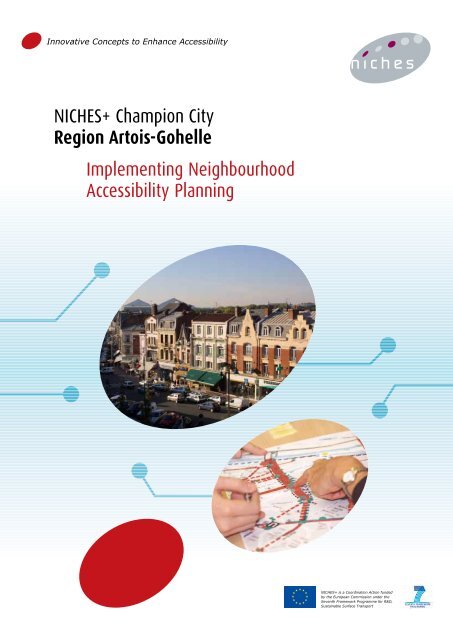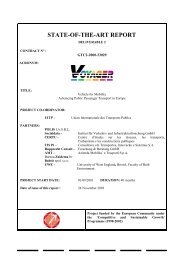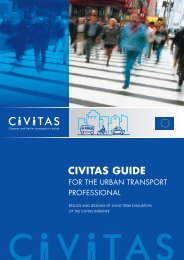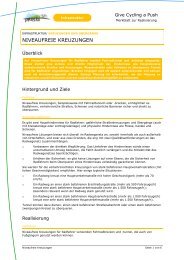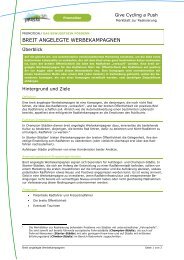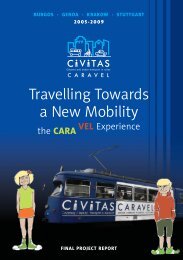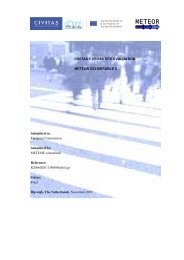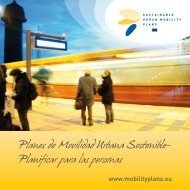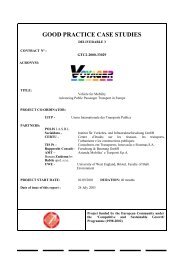NICHES+ Artois-Gohelle Neighbourhood Accessibility Planning
NICHES+ Artois-Gohelle Neighbourhood Accessibility Planning
NICHES+ Artois-Gohelle Neighbourhood Accessibility Planning
You also want an ePaper? Increase the reach of your titles
YUMPU automatically turns print PDFs into web optimized ePapers that Google loves.
Innovative Concepts to Enhance <strong>Accessibility</strong><br />
<strong>NICHES+</strong> Champion City<br />
Region <strong>Artois</strong>-<strong>Gohelle</strong><br />
Implementing <strong>Neighbourhood</strong><br />
<strong>Accessibility</strong> <strong>Planning</strong><br />
<strong>NICHES+</strong> is a Coordination Action funded<br />
by the European Commission under the<br />
Seventh Framework Programme for R&D,<br />
Sustainable Surface Transport
The Region and <strong>NICHES+</strong><br />
The project<br />
<strong>NICHES+</strong> is a FP7 co-ordination<br />
action aiming to network key actors<br />
actively engaged in developing<br />
innovative urban transport<br />
concepts and to facilitate the coordination<br />
of their activities across<br />
Europe. The project duration is from<br />
2008-2011.<br />
<strong>Artois</strong>-<strong>Gohelle</strong> is a Champion Region<br />
within the project that aims at<br />
implementing a <strong>Neighbourhood</strong><br />
<strong>Accessibility</strong> <strong>Planning</strong> (NAP) scheme.<br />
This document summarises an<br />
implementation scenario that gives<br />
advice on how to realise the given<br />
concept in the specific context of the<br />
city. This also provides an example to<br />
other cities interested in the uptake of<br />
the measure.<br />
The region<br />
<strong>Artois</strong>-<strong>Gohelle</strong> is a region located in<br />
northern France, which is characterised<br />
by a disperse polycentric settlement<br />
structure with many small towns and<br />
villages. The “urban heart” of the<br />
region is formed by the cities Lens<br />
(35,000 inhabitants) and Liévin (32,500<br />
inhabitants). The region is a former<br />
coal mining area, which is struggling<br />
with structural change and a high<br />
unemployment rate. Urban regeneration<br />
and renewal is therefore a key policy<br />
objective, in which attractive and<br />
accessible public transport services and<br />
urban environments also play an<br />
important role.<br />
The innovative concept<br />
The Syndicat Mixte des Transports<br />
<strong>Artois</strong>-<strong>Gohelle</strong> (SMT), which is the<br />
transport authority of the region, intends<br />
to implement a <strong>Neighbourhood</strong><br />
<strong>Accessibility</strong> <strong>Planning</strong> (NAP) scheme.<br />
This will require cooperation with local<br />
authorities (communes) in the region<br />
and takes into consideration<br />
experiences of European forerunner<br />
cities as Munich and Gothenburg.<br />
The focus of the NAP scheme in <strong>Artois</strong>-<br />
<strong>Gohelle</strong> would be to improve the<br />
accessibility for pedestrians and<br />
cyclists to the stops of a new tram<br />
line that is currently in planning. The<br />
idea is to implement some NAP pilot<br />
schemes in selected neighbourhoods.<br />
SMT plans to organise participatory<br />
workshops with inhabitants and other<br />
stakeholders in order to elaborate a<br />
priority list of measures to improve the<br />
accessibility of new tramway stations<br />
and their surroundings (pedestrian/<br />
cyclist catchment area).<br />
The implementation of the NAP scheme<br />
for <strong>Artois</strong>-<strong>Gohelle</strong> has not been<br />
confirmed yet. SMT is trying to establish<br />
cooperation arrangements with selected<br />
local authorities that have the<br />
responsibility for streets around the tram<br />
stops.<br />
District excursion with children and<br />
parents in Munich<br />
Photo: Kerstin Langer, KOMMA.PLAN<br />
City of Lens<br />
Photo: Rupprecht Consult<br />
1
The Challenge and the Vision<br />
The Challenge<br />
Mobility in the region is still heavily<br />
focused on the use of the private car<br />
(66% modal share). Public transport is<br />
only used for 3.5% of all trips.<br />
Currently the public transport services<br />
are based exclusively on a bus network<br />
and some special transport services. A<br />
tram project is on the way to establish a<br />
new link between the major<br />
agglomeration poles and to increase<br />
public transport ridership.<br />
One challenge is the currently still poor<br />
accessibility of public transport stops<br />
and the surrounding streets.<br />
The French <strong>Accessibility</strong> Act from<br />
2005 requires local transport authorities<br />
to make public transport fully accessible<br />
by 2015. In response to this, SMT<br />
developed an accessibility scheme with<br />
a comprehensive strategy to enhance<br />
the accessibility of public transport in the<br />
region over the coming years. NAP is<br />
part of this strategy.<br />
A big challenge for NAP is the<br />
fragmentation of responsibilities.<br />
SMT can only implement actions for<br />
streets that are remodelled in the<br />
context of the tram scheme. Local<br />
authorities are in charge of the<br />
sidewalks and most streets around<br />
public transport stops. They are still<br />
hesitant with concrete actions. A well<br />
accessible route to the public transport<br />
stops can only be achieved through<br />
cooperation between these two actors.<br />
“Implementing neighbourhood<br />
accessibility planning has two goals for<br />
us: by listening to people, we want to<br />
make public spaces around tramway<br />
stations more suitable for everyone, and<br />
we want inhabitants to make this project<br />
their own.”<br />
David Maubert, Head Manager,<br />
Syndicat Mixte Transports <strong>Artois</strong>-<br />
<strong>Gohelle</strong>, France<br />
The Vision<br />
SMT has the vision to remove<br />
accessibility barriers in the bus network<br />
and to plan the new tram line in a way<br />
that ensures “accessibility for all”.<br />
This broader vision of accessibility is not<br />
limited to public transport services and<br />
stops, which are in the direct<br />
responsibility of SMT, but includes the<br />
whole seamless travel chain from<br />
door-to-door. <strong>Accessibility</strong> should<br />
become a key element of a high quality<br />
public transport service in the region.<br />
With regard to NAP the vision is to start<br />
with two or three pilot areas, where the<br />
surroundings of new tram stops are<br />
made accessible for pedestrians<br />
(including people with mobility<br />
impairments) and cyclists, based on a<br />
participatory approach. NAP could be<br />
introduced on a wider scale in the region<br />
after a few successful pilot schemes.<br />
For the wider accessibility scheme SMT<br />
has set ambitious objectives for the<br />
year 2015. This includes amongst other<br />
things improvements in the accessibility<br />
of bus stops, a 100% low floor bus fleet,<br />
better passenger information about the<br />
accessibility of the public transport<br />
services, and soft measures to address<br />
psychological and cognitive barriers.<br />
Sidewalks and bus stops are frequently<br />
blocked by parked cars, Photo: SMT<br />
2
The Good Examples<br />
Munich, Germany<br />
A neighbourhood mobility concept<br />
(“Stadtviertelkonzept Nahmobilität“) was<br />
piloted in a selected Munich city centre<br />
area in 2001. Transport professionals<br />
from various organisations (different city<br />
departments, transport operator,<br />
consultancies) as well as organised<br />
stakeholder groups and citizens from the<br />
neighbourhood worked together in order<br />
to identify problems, assess them<br />
and develop concrete proposals for<br />
measures to improve the situation.<br />
The aim was to find effective, simple<br />
and reasonable measures to improve<br />
conditions for walking, cycling and<br />
other forms of non-motorised<br />
transport as well as for the locally<br />
relevant bus network.<br />
A key element of the approach was<br />
extensive citizen participation, which<br />
not only involved local interest groups<br />
but also “ordinary” citizens. The target<br />
group of the approach were all citizens<br />
of the neighbourhood, while children and<br />
older people benefited particularly from<br />
the proposed measures. The focus was<br />
on small measures, and on an<br />
organisational rather than a technical<br />
level (e.g. new benches, pedestrian<br />
crossings or improved lighting).<br />
The City of Munich continues to apply<br />
similar approaches in other<br />
neighbourhoods (e.g. Giesing).<br />
Contact in Munich<br />
Paul Bickelbacher, planner and<br />
councillor, e-mail: Paul.Bickelbacher@tonline.de<br />
“<strong>Neighbourhood</strong> accessibility planning<br />
is crucial for the liveability of inner city<br />
quarters. The participation of the<br />
citizens helps the planner to identify the<br />
people's needs and to find the right<br />
solutions.”<br />
Paul Bickelbacher, Councillor and<br />
planner, City of Munich, Germany<br />
Citizen participation in Munich<br />
Photo: Kerstin Langer, KOMMA.PLAN<br />
Gothenburg, Sweden<br />
The City of Gothenburg has a long<br />
tradition of making the public transport<br />
system more accessible.<br />
Roland Ahlgren, accessibility specialist<br />
at the City of Gothenburg, works on<br />
measures to enhance the<br />
accessibility of public transport stops<br />
and their surroundings, including<br />
pathways to and from the stops. This<br />
poses specific challenges such as the<br />
design of tram stops or the adaptation of<br />
crossings for people with reduced<br />
mobility or visual impairments.<br />
A key for the work on universal design of<br />
streets and public transport stops was to<br />
get the most out of the available budget<br />
and to identify a programme of<br />
priorities. This approach proved to be<br />
successful in finding cost efficient<br />
solutions that respond to the user<br />
needs.<br />
Contact in Gothenburg<br />
Roland Ahlgren, accessibility specialist,<br />
City of Gothenburg, e-mail:<br />
roland.ahlgren@trafikkontoret.goteborg.<br />
se<br />
For further details on the Munich and<br />
Gothenburg cases see the <strong>NICHES+</strong><br />
website section on NAP (www.nichestransport.org).<br />
3
The Users and Implementers<br />
The user needs<br />
In the case of the NAP concept, there is<br />
a large variety of citizens and actors<br />
involved, all of whom have very<br />
different needs and expectations.<br />
Not only tram users will benefit from<br />
improvements to accessibility but also<br />
all people living or visiting the concerned<br />
areas. These people have certain needs<br />
related to mobility and urban planning.<br />
First of all the measure should ensure<br />
easy access to the new tram lines and<br />
enable independent and healthy<br />
mobility. Residents and visitors of the<br />
concerned areas also need a high<br />
liveability of the neighbourhood (e.g.<br />
meeting opportunities, sharing of space,<br />
tidiness, playgrounds, green areas).<br />
Local businesses need an environment<br />
that facilitates economic life in the<br />
area, e.g. through attractive public<br />
spaces that attract customers.<br />
With regard to the participatory process<br />
the concerned actors require sound<br />
information and open involvement. All<br />
travel modes should be considered and<br />
the involved citizens should be enabled<br />
and encouraged to work on challenges<br />
in an active way together with the<br />
responsible authorities. This also<br />
requires a realistic management of<br />
expectations about what a public<br />
authority can do with given resources<br />
and time.<br />
Accessible model bus stop in Liévin<br />
Photo: SMT<br />
The key stakeholders for<br />
implementation<br />
The concept of NAP can be<br />
characterised by the need for a multistakeholder<br />
co-operation and the<br />
involvement of different user groups<br />
through public participation.<br />
Key players to drive the process forward<br />
are SMT and the representatives of<br />
the local communes. SMT will be<br />
organising the public participation<br />
process, supported by a subcontracted<br />
external moderation expert.<br />
The status analysis regarding the<br />
accessibility of tram stops and their<br />
catchment areas as well as drawing-up<br />
of a list of priorities will be carried out by<br />
SMT and the co-operating communes.<br />
The communes need to be closely<br />
involved in all steps and finally take<br />
forward the realisation of measures that<br />
are suggested in the process.<br />
Especially vulnerable members of<br />
society would benefit from a NAP<br />
scheme in <strong>Artois</strong>-<strong>Gohelle</strong><br />
Photo: Rupprecht Consult<br />
Key for realising a NAP scheme in<br />
<strong>Artois</strong>-<strong>Gohelle</strong> will be the support of the<br />
political representatives of the<br />
communes. This still requires some<br />
awareness-raising.<br />
4
The Transferability Potential<br />
The transferability to <strong>Artois</strong>-<br />
<strong>Gohelle</strong><br />
The good practice cases of Munich and<br />
Gothenburg have been the key<br />
references for the transfer of the NAP<br />
concept into <strong>Artois</strong>-<strong>Gohelle</strong>.<br />
The main factors that support<br />
transferability are:<br />
• <strong>Accessibility</strong> policy of SMT: with<br />
the new tram project, not only the<br />
vehicles and stops shall become<br />
accessible, but also the pathways to<br />
the trams. The big investment into a<br />
new tram line only makes sense if<br />
the tram stops are accessible from<br />
the surrounding streets (catchment<br />
area). SMT’s awareness for these<br />
issues is a key driving force for<br />
implementation. SMT’s official<br />
accessibility scheme includes NAP<br />
as one of the measures.<br />
• Funding for participatory process:<br />
within the accessibility scheme there<br />
is also budget for paying a<br />
specialised external moderator to<br />
run the participatory process.<br />
• Focus on small and cost efficient<br />
measures: as seen in Gothenburg,<br />
measures to improve the<br />
accessibility to and from public<br />
transport stops do not need to be<br />
very expensive. This could facilitate<br />
an easier implementation of NAP in<br />
<strong>Artois</strong>-<strong>Gohelle</strong>.<br />
• Potential link-up to urban renewal<br />
activities (it still needs to be<br />
checked where NAP areas and<br />
urban renewal areas would coincide)<br />
When considering constraints for<br />
transferability the main issue at the<br />
moment is still the lack of awareness<br />
and political support for the topic on<br />
the level of the communes.<br />
It can be concluded that transferring the<br />
NAP concept for the specific case of<br />
improving the surroundings of some pilot<br />
areas around tram stops will be<br />
challenging, but seems feasible if<br />
political support in the communes can<br />
be activated.<br />
Site visit on accessibility issues in<br />
Gothenburg<br />
Photo: Rupprecht Consult<br />
The general transferability of<br />
<strong>Neighbourhood</strong> <strong>Accessibility</strong><br />
<strong>Planning</strong><br />
In general the concept is highly<br />
transferable, while there is a wide<br />
variety of possible participatory tools<br />
and measures, which need to be tailored<br />
to the local situation.<br />
The key for success is strong political<br />
back-up and a budget for the<br />
participatory process and measures<br />
implementation.<br />
<strong>NICHES+</strong> transferability workshop in<br />
Munich<br />
Photo: Rupprecht Consult<br />
5
The Implementable Measure<br />
The measure justification<br />
It is clearly visible in <strong>Artois</strong>-<strong>Gohelle</strong> that<br />
many streets are not designed or<br />
maintained in an adequate manner for<br />
pedestrians and cyclists and even less<br />
for mobility impaired people. Their<br />
generally poor condition is a severe<br />
obstacle not only for moving within the<br />
cities, but also for achieving a higher<br />
use of public transport.<br />
The two new tram lines that are<br />
currently in the planning phase<br />
represent an opportunity to improve this<br />
situation. The building of the tram lines<br />
will require a lot of roadwork. This will<br />
follow the latest accessibility<br />
standards. At the same time access to<br />
the new tram line needs to be ensured<br />
for the whole catchment area. Also in<br />
terms of urban renewal requirements,<br />
NAP offers the opportunity to make<br />
some of the areas around tram stops<br />
more attractive, with the chance to<br />
attract businesses and social<br />
activities for more vibrant communities.<br />
The implementable measure<br />
The following summarises what is<br />
suggested as the main activities for a<br />
NAP scheme in <strong>Artois</strong>-<strong>Gohelle</strong>:<br />
• Create a cooperative environment<br />
between SMT and the participating<br />
communes as well as other relevant<br />
stakeholders. Through the work in<br />
<strong>NICHES+</strong> some interest among<br />
three municipalities (communes de<br />
Liévin, Lens and Houdain) could be<br />
generated. SMT aims to work in a<br />
co-operative approach with the<br />
communes on a better accessibility<br />
of the surroundings of newly planned<br />
tram stops. The chances for NAP<br />
pilot schemes will strongly depend<br />
on the political commitment of these<br />
communes and the decision on the<br />
final route of the new tram line.<br />
• Strive for linking-up to existing<br />
programmes in urban renewal or<br />
social programmes to exploit<br />
possible synergies and funding<br />
opportunities.<br />
• Define planning areas for NAP<br />
when participating communes have<br />
been confirmed. The areas around<br />
the tram stops should cover at least<br />
the catchment area for pedestrians<br />
(400m minimum). Ideally a wider<br />
catchment area for cyclists should<br />
be considered.<br />
• Fix budget for process and<br />
measures in advance. This<br />
facilitates the process and sets a<br />
clear framework for all activities. If<br />
there is only little money available, it<br />
is better to focus on small and lean<br />
measures that are less costly. If<br />
sufficient budget is available, the<br />
process may include some effective<br />
measures with higher costs (e.g.<br />
infrastructure works).<br />
• Set-up of co-operation<br />
arrangements with external<br />
planner and moderator. SMT has<br />
already set aside 75,000 EUR for<br />
contracting a consultant that runs<br />
the participatory process.<br />
• Carry out accessibility inventory<br />
for selected areas and present in<br />
easy to grasp form. SMT has already<br />
developed a methodology to assess<br />
bus stop accessibility which could be<br />
used as a basis for further work.<br />
• Carry out participatory process<br />
with citizens and other stakeholders<br />
to define priority list for increasing<br />
the accessibility of the neighbourhood.<br />
Orientation for designing the<br />
participatory process has been<br />
provided by the Munich example. A<br />
feasible approach that would take<br />
about 7 months could include district<br />
excursions with residents, several<br />
meetings with working groups that<br />
discuss possible improvements and<br />
a citizen jury with randomly picked<br />
participants that discuss the final<br />
priority list of measures.<br />
6
The Implementable Measure<br />
• Draw-up priority list of<br />
recommended measures, e.g.<br />
engineering, education, marketing,<br />
encouragement, enforcement,<br />
environmental and policy initiatives.<br />
The special needs of more<br />
vulnerable groups such as disabled<br />
and older people as well as children<br />
should particularly be taken into<br />
account.<br />
• Evaluate costs of<br />
recommendations and clarify<br />
financing strategy.<br />
• Implement measures to enhance<br />
the accessibility of the<br />
neighbourhood.<br />
• Provide follow-up communication<br />
and expectation management with<br />
citizens to avoid frustration if<br />
measures take a time to be<br />
implemented.<br />
The finances<br />
SMT has foreseen 75,000 EUR for the<br />
participatory process. This includes<br />
the sub-contracting of the external<br />
moderator as well as the organisation of<br />
events. Furthermore resources in form<br />
of staff time will be needed from SMT<br />
and the involved communes. The<br />
definition of the budget for measure<br />
implementation will need to be<br />
discussed with the communes that will<br />
be participating in the scheme. This can<br />
reach from small cost-efficient measures<br />
to larger infrastructure works, depending<br />
on aims and available funding.<br />
The timing<br />
A NAP scheme requires some months<br />
of preparation and some months for<br />
carrying out the participatory process,<br />
which leads to a priority list of measures.<br />
The measure implementation itself can<br />
take a few weeks up to a few years.<br />
The long-term perspective<br />
It is recommended to include a<br />
manageable monitoring and<br />
evaluation procedure to learn about the<br />
impact of the project and to give<br />
feedback to involved stakeholders and<br />
citizens. An evaluation that shows the<br />
benefits of enhancing neighbourhood<br />
accessibility can deliver important<br />
arguments to strengthen this field with<br />
local decision makers.<br />
Assuming that some pilot NAP schemes<br />
will be successful, it is advisable to think<br />
on time about a follow up strategy to<br />
expand the NAP approach also to<br />
other neighbourhoods around public<br />
transport stops. Key to the long-term<br />
perspective would be to get more and<br />
more communes on board by convincing<br />
them about the benefits of the approach.<br />
Poorly accessible bus stop at Lens<br />
Hospital, Photo: Rupprecht Consult<br />
Improved pedestrian crossing on the route<br />
to a tram stop in Gothenburg<br />
Photo: Rupprecht Consult<br />
7
The Lessons Learnt<br />
<strong>Neighbourhood</strong> <strong>Accessibility</strong> <strong>Planning</strong><br />
can become a key tool for improving<br />
conditions for walking and cycling at<br />
the local level. It does not only address<br />
the mobility aspect but also has the<br />
potential to create more lively<br />
communities and foster better use of<br />
public space and social inclusion.<br />
The concept is in general easily<br />
transferable. The multi-stakeholder<br />
environment of NAP however requires a<br />
good management of the process.<br />
The experience in <strong>Artois</strong>-<strong>Gohelle</strong> shows<br />
that awareness raising and political<br />
commitment are a first step to enable<br />
NAP processes. It will be a key aspect in<br />
<strong>Artois</strong>-<strong>Gohelle</strong> to activate political<br />
support for a co-operation of SMT<br />
(public transport authority) with the local<br />
communes.<br />
Fragmented<br />
responsibilities can otherwise become<br />
a major barrier for implementation.<br />
The examples of forerunner cities as<br />
Munich and Gothenburg provide mature<br />
methodologies and processes for<br />
running a NAP process, which SMT and<br />
the communes could apply in pilot<br />
projects to the surroundings of tram<br />
stops. The aim would be to expand NAP<br />
schemes after these first “experiments”<br />
on a wider scale to achieve a higher<br />
impact.<br />
All citizens benefit from <strong>Neighbourhood</strong><br />
<strong>Accessibility</strong> <strong>Planning</strong><br />
Photo (Munich): Paul Bickelbacher<br />
Check list<br />
The following check-list summarises key<br />
aspects for <strong>Neighbourhood</strong><br />
<strong>Accessibility</strong> <strong>Planning</strong> and intends to<br />
give the reader advice on whether the<br />
concept is suitable for their own context.<br />
Check list<br />
City size<br />
Key<br />
conditions<br />
for implementation<br />
Resources<br />
Implementation<br />
time<br />
Stakeholders<br />
involved<br />
Undesirable<br />
secondary<br />
effects<br />
No restrictions, wide range of<br />
settlement structures suitable. The<br />
planning area should be of<br />
manageable size.<br />
• Strong political back-up and predefined<br />
budget for participation<br />
process and measures.<br />
• Will to involve the citizens and to<br />
co-operate with many<br />
stakeholders.<br />
• Internal expertise to manage the<br />
process or budget to subcontract<br />
external moderators and<br />
planners.<br />
Staff time and possibly external<br />
moderation for participatory process.<br />
Costs can be considered as being<br />
moderate.<br />
Budget for measure implementation<br />
depending on measures prioritised.<br />
Can be low cost (e.g. regulation) to<br />
high cost (e.g. infrastructure).<br />
Several months preparation and<br />
several months for participation.<br />
Measure implementation in short to<br />
long-term.<br />
• Local authority (different<br />
departments)<br />
• Citizens in general<br />
• Local institutions such as<br />
schools and kindergartens<br />
• Local interest groups (e.g. older<br />
people associations)<br />
• Local businesses<br />
• Public transport operators<br />
• External moderators and<br />
planners (optional)<br />
Long-term: If not tackled, possibly<br />
increasing gentrification<br />
(displacement of poorer people in<br />
inner city neighbourhoods that<br />
become more attractive and<br />
expensive to live in).<br />
8
<strong>NICHES+</strong> is a Coordination Action funded<br />
by the European Commission under the<br />
Seventh Framework Programme for R&D,<br />
Sustainable Surface Transport<br />
21582_policynotesWG1_2.indd 1 2/06/10 9:28:09<br />
Innovative Concepts to Enhance <strong>Accessibility</strong><br />
GUIDELINES FOR IMPLEMENTERS OF<br />
<strong>Neighbourhood</strong> <strong>Accessibility</strong> <strong>Planning</strong><br />
For further details on how to implement<br />
<strong>Neighbourhood</strong> <strong>Accessibility</strong> <strong>Planning</strong><br />
schemes please see the <strong>NICHES+</strong><br />
Guidelines for implementers<br />
(available from www.niches-transport.org).<br />
The more detailed full version of the<br />
Implementation Scenario for<br />
<strong>Neighbourhood</strong> <strong>Accessibility</strong> <strong>Planning</strong> in<br />
<strong>Artois</strong>-<strong>Gohelle</strong> is also available on the<br />
<strong>NICHES+</strong> website.<br />
Photo on title page<br />
Photo left hand: Kerstin Langer, KOMMA.PLAN (shows<br />
participatory workshop in Munich);<br />
photo right: SMT <strong>Artois</strong>-<strong>Gohelle</strong> (shows Lens city)<br />
Prepared for the European Commission by :<br />
Sebastian Bührmann, Rupprecht Consult,<br />
s.buehrmann@rupprecht-consult.eu<br />
February 2011<br />
Co-author and contact<br />
in the Champion City<br />
Hervé Lambert, Syndicat Mixte des Transports <strong>Artois</strong>-<strong>Gohelle</strong><br />
HLambert@smt-llhc.fr<br />
<strong>NICHES+</strong> team<br />
POLIS (coordinator, Ivo Cré: icre@polis-online.org),<br />
Rupprecht Consult, Newcastle University,<br />
University of Southampton, EUROCITIES, Transman<br />
Further information on <strong>NICHES+</strong><br />
www.niches-transport.org<br />
www.osmose-os.org<br />
This document has been prepared by the authors in<br />
the framework of a project funded by the European Commission,<br />
DG Research. It does however not necessarily reflect the views<br />
of the European Commission.<br />
<strong>NICHES+</strong> is a Coordination Action funded<br />
by the European Commission under the<br />
Seventh Framework Programme for R&D,<br />
Sustainable Surface Transport


